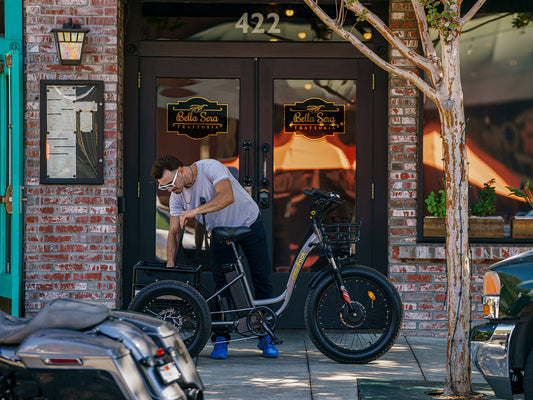Winter, a time when days are shorter and the chill in the air invites new challenges for cyclists. It is not like summer when simply wearing a helmet and a few light clothing items suffices. You need to a special attire that safeguards you from the cold.
Keeping this in view, this comprehensive winter cycling guide presents 10 essential clothing items you need to wear cycling in winter. We will be covering everything from head to toe. Let’s get started.
1. Cycling Cap
Your helmet’s air vents are great for summer but come winter, they can make your head cold. A cycling cap, especially a thicker, insulated one, solves this. Worn under your helmet, it keeps your head warm. For even colder days, opt for winter caps made from double-layered wool or cotton. They cover your ears too, and protect against cold winds.
2. Neck tube
After the head, your neck needs attention. A neck tube, or neck warmer, might seem like an ordinary accessory, but it’s important for winter cycling. It keeps your neck warm and serves as a breathable layer. This is quite helpful when the temperature drops significantly.
3. Sunglasses
Yes, sunglasses are needed in winter too! The winter sun, low in the sky, can impair visibility, particularly when its light reflects off wet roads or snow. Sunglasses protect your eyes from road grit and salt. They also shield your face from direct snowy winds.
4. Thermal Base
Unlike summer, cycling in winter requires layered clothing. Start with a thermal base. Choose a long-sleeved one, preferably made of merino wool. This material is breathable and wicks sweat away. A bonus: it is less prone to odor than synthetic fabrics. It is soft on your skin and comes in various neutral shades. Depending on the weather, you can add more layers but always start with this fundamental piece.
5. Gloves
Hands need protection too! The colder it gets, the more challenging it can be to operate your gears and brakes. Warm fingers are vital. A pair of thick, water-resistant, or even waterproof gloves is a wise choice. Look for gloves with silicone grippers and reflective strips for safer signaling. A microfibre wipe on the glove is handy for keeping your nose clean.
6. Gilet
A gilet is a great addition to your winter cycling wardrobe. It is more like a jacket but without arms, similar to a body warmer.
Best for sunny days, they're often made from windproof material. A big plus is their portability – they can be easily rolled up and stored in a jersey pocket when you don't need them.
7. Waterproof Jacket
When winter weather turns harsh, a softshell jacket or gilet won’t be sufficient. You will need a top-quality waterproof jacket. This jacket is essential for staying dry and comfortable in rain or snow. Look for features like breathable fabric, sealed seams, and a snug hood.
8. Cycling Bib Tights
As the temperatures drop, cycling bib tights become an essential part of your winter gear. Unlike regular tights or pants, bib tights are designed specifically for cyclists. They offer full leg coverage, which is essential for keeping muscles warm and preventing cramping or discomfort. Many bib tights come with padding in the seat area which provides extra comfort during long rides.
9. Socks
The ideal choice for winter cycling socks is merino wool. This material excels in trapping warm air around your feet, providing insulation in cold conditions. At the same time, it is breathable i.e. the sweat doesn't build up and cause discomfort.
10. Overshoes
In winter, many cyclists struggle with numb toes, a problem that worsens with wet feet. To combat this, a pair of warm, insulated, and waterproof overshoes is recommended.
Overshoes are designed to be worn over your cycling shoes. They provide an extra layer of protection against cold and moist conditions, maintaining warmth and dryness.
How to Ride in Winter [5 Care Tips]
Gathered all those clothing accessories? And prepared for your winter ride? Here are a few that might help to make cycling in winter comfy and fun:
Layer Smartly for Warmth
Begin your ride a bit cold. You'll warm up as you cycle, generating body heat. Start with a light base layer for sweat, then add your jersey, bib shorts, and warmers. Top it off with a thermal or winter cycling jacket. In extreme cold, consider thermal bib tights and a vest. Peel off layers before you sweat too much; wet clothes can freeze.
Protect Your Extremities
Your arms, legs, fingers, and toes need special attention. For fingers, find gloves that keep them warm yet mobile. Shoe covers are important too! They protect them from wind and cold without adding bulk.
Speed vs. Chill Factor
Speed affects how cold you feel. Biking at lower speeds (6-10 mph) feels warmer than fast road riding due to less wind chill. Also, choose your routes wisely; sheltered paths are warmer.
Cold-Proof Your Snacks
Your body burns more energy in the cold. Get soft, easy-to-eat foods like fruit, oat bars, and sandwiches. Avoid hard foods that might freeze.
Get Hydrated
Winter impacts hydration differently. You need more fluids in high-intensity rides and less in low-intensity ones. Know your normal hydration rate and adjust based on your activity level and sweat rate.
Conclusion
Winter is one of the most beautiful seasons of the year, painting the world in a unique, serene landscape. It’s not a time to stay indoors, feared by the cold. Instead, it’s time to enjoy but with an extra measure of care. An extra layer of clothing can make all the difference. By dressing appropriately and following these tips, you can enjoy the season to its fullest/




